
Distance (m)
4
3
2
1
0
1
2
3
4 4
3
2
1
0
1
2
3
0
10
10
20
30
40
50
Phase
Phase
300 MHz
600 MHz
Trace
376
Trace
372
Figure 4. 300- (left) and 600- (right) MHz diffraction profiles and waveform responses to a
metal disk buried 58 cm deep. The amplitude of the 600-MHz diffraction fades rapidly as
distance increases from the target. The diffracted wavelets (darkened areas) within the sample
traces have a half-cycle polarity sequence that is characteristic of the response of this an-
tenna system's wavelets from a metal target.
The amplitude along the 600-MHz hyperbolic as-
latter range is consistent with the gain we added before
ymptotes in Figure 4 rapidly fades with distance from
recording and with soil attenuation rates discussed later.
the target. This indicates a very high soil attenuation
The volumetric water content profiles of soil core
rate per meter; the change in antenna directivity with
samples (obtained before rain occurred) show values
angle to the target (discussed later) is an insignificant
from about 15% at the surface to as high as 40% at 30
loss factor. Commercial GPR systems at these frequen-
180 cm deep (Fig. 5). The water contents within the
cies commonly have a performance figure of about 100
profile of the core obtained about 24 hours after steady
120 dB and a dynamic range (the amplitude range vis-
rain had begun ranged from 23 to 45%, the latter of
ible in any particular trace) of about 6070 dB. This
which is at about saturation for this type of soil. The
0.5
0.4
0.3
0.2
0.1
0.0
0
5
10
15
20
25
30
35
Depth (cm)
a. Profile 1.
Figure 5. Soil moisture profiles at five locations.
7



 Previous Page
Previous Page
